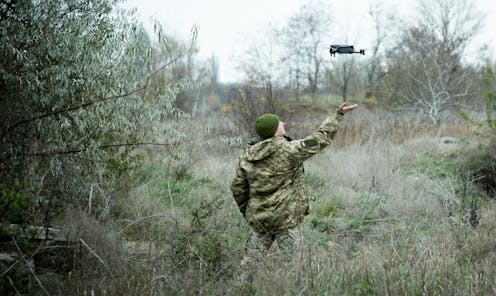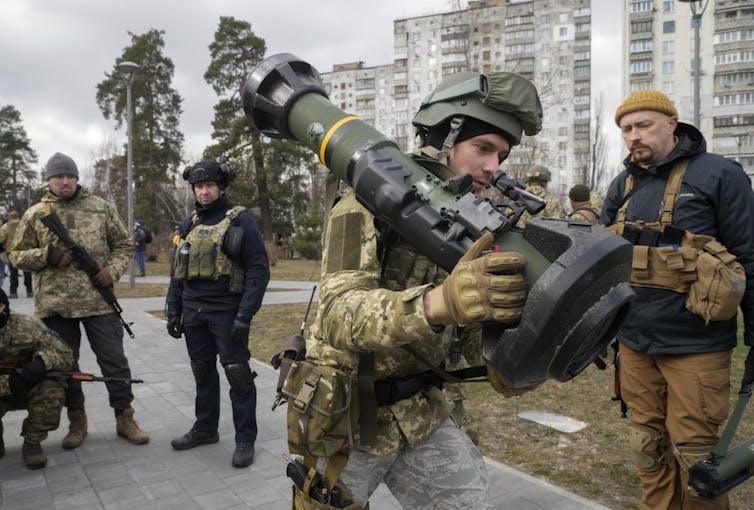Lesson from a year at war: In contrast to the Russians, Ukrainians master a mix of high- and low-end
A year ago, the Ukrainian military was largely equipped with Soviet-era weapons. It has since seen an influx of high-tech weapons. But it’s less what than how that’s made a difference.

In less than a year, Ukraine’s military has emerged as a modern, effective fighting force in large part due to an abundance of technology provided by the United States and its NATO allies.
On Feb. 24, 2022, the date of the Russian invasion of Ukraine, the Ukrainian military was still dependent on Russian-made military equipment, much of which was antiquated. Today it fields high-tech Western weapons systems like High Mobility Artillery Rocket System (HIMARS) and anti-radar missiles.
However, it is not technology alone that wins battles. Ukraine has managed to receive a large assortment of NATO equipment, learn how to use it and bring it to the battlefield with impressive speed and effectiveness. The past year has seen Ukraine become a technical fighting force, able to combine different levels of technology in support of a cohesive strategy.
In contrast, this year has shown that Russia, despite having modern technology and weapons, has been unable to use its seeming technological advantage due to poor leadership, bad strategy and lack of competence.
Much of the attention on Western-furnished technology has focused on top-tier systems like the Patriot missile battery, HIMARS, High-speed Anti-Radiation Missile (HARM) and Javelin portable antitank missile, and other precision anti-tank weapons. This does not do justice to the scale of technology Ukraine is using on a daily basis across the war zone.

Three tiers
Military technology in the war in Ukraine can be categorized in three tiers. The weapon systems mentioned above fall in the high-end tier. These systems have proved to be powerful weapons in the hands of Ukrainians, but have somewhat limited utility due to cost and training requirements. These factors limit the number of systems available to Ukrainian forces. Ukraine now fields 20 HIMARS, and will get only a single battery of the Patriot system.
The Patriot alone requires several months of training in the U.S. In addition to the training burden, these weapons require a large support system of highly specialized parts and maintenance. The long logistics tail for the highest tech systems decreases their utility. These high-end systems are critical to Ukraine’s fight, but need to be supplemented by mid- and low-tier systems that can be delivered and used in large numbers.
The mid-tier systems include drones like Turkey’s Bayraktar TB2 and the American-made Switchblade and ScanEagle. These systems have been provided in the hundreds and come with minimal outside training requirements, while offering an immediate advantage on the battlefield. This level of technology requires less training, which means it can enter the battlefield much more quickly and be put in more hands.
The ability to provide weapons systems that are more cost-effective and less training-intensive has supported the efforts to get high-end systems into Ukrainian hands by buying the Ukrainian military time. With mid-level technology as a stopgap, Ukraine has been able to meet the immediate Russian threats while preparing to use high-tech systems.
The low-end tier of systems should not be mistaken as less important than the other classes of weapons and capabilities. This tier includes commercially available, off-the-shelf products that have proved to be game changers in Ukraine, products like commercial quadcopter drones and Starlink satellite internet terminals.
Commercial technology has allowed Ukrainian forces to equip themselves with capabilities that dramatically improve command and control, communications and overall situational awareness. Command and control in a military context refers to battlefield commanders being able to efficiently direct the forces and systems under their command. Situational awareness in a military context refers to knowing battlefield conditions, including the positions and status of friendly and enemy forces.
Putting it together
Ukraine’s success has come by figuring out how to integrate these three tiers of weapons and technology into a cohesive battlefield strategy. They use Starlink to ensure connectivity between commanders, personnel who identify targets and front-line units who attack those targets.
Drones based on commercial quadcopters that have been retrofitted for military use and mid-tier drones provide critical targeting and surveillance data in real time. This connectivity and airborne intelligence allows small, mobile units to use their limited supplies of precision high-end munitions to greatest effect.
The speed with which Ukraine has taken this hodgepodge of technology and capabilities and mastered their integration and use is remarkable. It provides a stark contrast to Russia’s use of technology.
Russian mismanagement
In February 2022, Russia appeared to be technologically superior to Ukraine on the battlefield. The Russian military has continually failed to capitalize on this advantage because of poor command and control, lack of expertise and dismal performance of troops in the field.
Russia has faced many of the same pressures as Ukraine to adapt to new technology and has come to some similar solutions. Russian forces have also used quadcopter drones for tactical surveillance and reconnaissance, and, like the Ukrainians, have fitted some with grenades. They have hit civilian as well as military targets with Iranian-made Shahed-136 drones, which are a form of loitering munition that can fly overhead until a target is identified and detonate on impact.
Russia has embraced mid-level technology because it has been hesitant to commit its most advanced weapons systems like the beleaguered Su-57 fighter jet or the T-14 Armata tank, which was only recently deployed in Ukraine. Russia has been unable to secure air superiority or destroy Ukraine’s air defenses or long-range artillery, which means committing Russia’s best weapons puts them at great risk.
However, Russia still maintains an advantage in long-range precision strike weapons like cruise missiles. Despite the size of its arsenal, Russian forces have continued to squander their technological advantage and rely on low-quality, foreign options like the Shahed. The Russian military has failed to suppress Ukraine’s robust defenses while simultaneously relying on poor tactics, leadership and training.
Lessons from the war
While Russian forces continued to mismanage their technology, Ukraine was mastering theirs. This provides the key lesson for the West. The mere existence of cutting edge technology and high-tech weapons does not provide a military with a guarantee of success.
Western militaries can look to Ukraine for an example of how to integrate technologies and weapons to remain agile and adaptable. At the same time, they can look to Russia as an example of the dangers of lack of competence and poor command and control.
Ukraine is a window into future warfare. The next wars will also hinge on which side can better use all levels of technology and integrate them into a coherent strategy. Technology is a game changer, but only for those who make the best use of it.
The author is an officer in the United States Air Force. The views expressed are those of the author and do not reflect the official position of the United States Air Force or Department of Defense.
Read These Next
As DOJ begins to release Epstein files, his many victims deserve more attention than the powerful me
Powerful men connected to Jeffrey Epstein are named, dissected and speculated about. The survivors,…
How to reduce gift-giving stress with your kids – a child psychologist’s tips for making magic and a
Depending on family circumstances and a child’s personality type, gift giving runs the gamut of fun…
The world risks forgetting one of humanity’s greatest triumphs as polio nears global eradication − 7
Polio may finally be defeated in the next 5 years. Will the world recognize what an extraordinary achievement…





